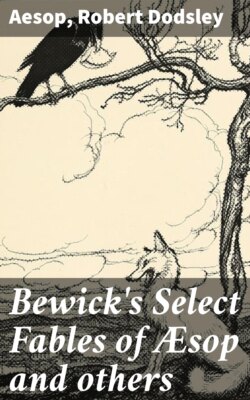Читать книгу Bewick's Select Fables of Æsop and others - Aesop - Страница 6
На сайте Литреса книга снята с продажи.
AN ESSAY UPON FABLE.
ОглавлениеTable of Contents
Fable is the method of conveying truth under the form of an Allegory. The sense of a Fable is entirely different from the literal meaning of the words that are used to compose it; and yet the real intention thereof is visible and manifest, otherwise the Fable is not well composed. The sense of a Fable of the moral kind ought always to be obvious at first view, that the instruction intended to be given may have as early an effect as possible.
The chief thing to be considered in a Fable is the action, which conveys the moral or truth designed for instruction. There ought only to be one action in a Fable, which must appear through the whole; otherwise it will be liable to admit of different interpretations, and be the same as a riddle, and have no effect. Clearness, Unity, and Probability, are incidents essentially necessary in a moral Fable. If a Fable be not so plain as to point out the sense of the writer clearly, but admit of different interpretations, it does not answer the true design thereof. If the incidents tend to convey different ideas, then the reader will be at a loss to understand the chief intention of the author. All the various incidents ought manifestly to unite in one design, and point out one clear and perspicuous truth. Many of the modern Fables labour under this defect; the incidents do not manifestly tend to point out the moral. Fontaine’s Fable of the two pigeons, and Croxall’s story of the coach-wheel, are of this sort.
The incidents of a Fable ought also to have a real foundation in nature. This rule may be infringed by ascribing to creatures appetites and passions that are not consistent with their known characters. “A Fox should not be said to long for Grapes.”[9] The rule of Horace will hold universally—
Sed non ut placidis cœant immitia: non ut
Serpentes avibus geminentur, tigribus agni.
Delphinum Sylvis appingit Fluctibus aprum.
—Horace, I. 13.
To join the wild with creatures that are tame,
Serpents with birds, or tygers with the lamb,
Paint whales in woods, and wild boars in the sea,
Ah, what a motley piece the whole would be!
Creatures different in their nature must not be associated in a just Fable. The Lamb must not be made to travel with the Fox, nor the Wolf and the Sheep to feed or associate together; for all this is unnatural, and can never be rendered a probable object of belief. The incidents in a Fable ought also to be few, lest by crowding circumstances too close, the whole appear confused, and perplex the mind.
The next thing to be considered in Fable is the imagery or characters; these may either be men, beasts, or inanimate beings. All these have been introduced by the ancient Fabulists. In all personifications the rules of analogy are to be observed; in those things wherein man and other creatures have no similitude, no true image can be formed in what respects human society. The persons and characters assumed in Fables, ought therefore to have a likeness to the things to which they are compared. All nature may serve to furnish a Fabulist with machinery. Mountains, rivers, trees, animals, and even invisible powers may answer his purpose; but, in the use of all sorts of machinery, a proper regard must always be held to analogy. When language is attributed to animals, they must not be made to speak in a style which bears no similitude to some property in their nature; an owl must not be made to sing like a nightingale; nor should a raven be made the symbol of an orator. When beasts are made the representations of men, there ought always to be something in their nature that bears a similitude to their character. The same may be said of things inanimate; a strong man may be compared to a mountain, but it would be preposterous to make the same comparison of a dwarf. Vices and virtues ought in the same manner to be delineated in Fable; a proud man may be compared to a high hill, a humble person to a low valley. This is authorised by the writings of the Old Testament: The high mountains shall be brought low, and every valley shall be exalted.
When human actions are attributed to invisible powers, or especially to the Deity, they ought to be such as are worthy of those ideas which are generally received concerning him. In this, Homer is very faulty; for he exalts his men almost to Gods, and brings down his Gods to the level of beasts.
As for the style of Fable, simplicity is the greatest excellence; that familiar manner of speech in which we converse is best suited for the purposes of Fable. This manner of writing is more difficult to attain than is generally imagined; it requires a particular taste, and is harder to imitate than the sublime itself. The style of a Fable must always be adapted to the characters which are introduced: for it would be absurd to make the eagle speak in the same style with the bat; or the King of the forest express himself in the language of the mouse. But in all these particulars, nature will be the best guide; and where this is deficient, no art can supply the want of it.
